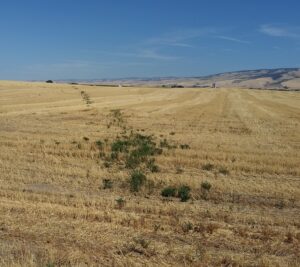By Ian Burke and Nick Bergman
Herbicide resistance has been a common topic request for regional weed scientists for decades. “How do I manage herbicide resistance?” is the common question we hear from farmers. Often the question is reactive — there has been a failure such that there is now an emergency or, worse, a complete lack of ability to manage the weed with herbicides. We’ve identified an array of best management practices to manage weeds in general and mitigate herbicide resistance specifically. These resources are available to farmers for free through Washington State University Extension and the Washington Grain Commission (WGC). Access these free resources at the WGC grower management publications page. We have also grappled with getting farmer adoption of those best management practices on a farmer-by-farmer basis.

What has become increasingly obvious to those of us working in weed science is that it’s a problem that needs a collective response. Given the array of dispersal mechanisms weeds use — think tumbleweeds, pollen spread, dispersal through contaminated tillage and harvesting equipment — it’s really the weakest link (a farmer repeatedly applying the same herbicide, for example) in the system that causes the problem. Any single farmer likely won’t be able to solve the looming failure of a herbicide like glyphosate causes. All the rest of us must deal with it.
The idea that one person can ruin it for the rest of us is not a new one. It’s typically referred to as the “tragedy of the commons.” Commons refers to common-pool resources. The typical example of a common-pool resource is fish. If a few overfish, then the rest are left without fish. Water is another example. In each case, the resource is finite, and overexploitation leads to exhaustion of the resource.
Herbicide susceptibility is of a similar nature — it can be viewed as a common-pool resource. If the weeds remain susceptible to herbicides, we all benefit from the continued use of that herbicide. If a few use a single herbicide over and over again, this practice causes natural selection for resistance, and then that resistance spreads to everyone else’s fields. A few have used up the resource, and the rest of us can no longer utilize that herbicide susceptibility.
There are an array of examples. Remember Glean? Glean completely controlled Russian thistle, and then it didn’t. Now we rarely use that herbicide, if at all. Harmony Extra? An effective and inexpensive tool for managing mayweed chamomile and many other broadleaf weeds. Seldom used any more. Resistance to each herbicide developed in pockets and spread throughout the region. It’s happening right now with cheatgrass and Group 2 herbicides.
Managing common-pool resources is challenging. One approach is to use regulation. Everyone needs a fishing license, there are strict limits on the number of fish you can catch, and government controls the resource, as an example.
In principle, regulation of herbicide susceptibility is not a viable solution. If we are going to commit to the preservation of herbicides as tools, we need to work together. Or at least commit to managing weeds more intensively, with a broader array of tools and tactics. We will likely need to talk about it, too. Management of common-pool resources requires, to a certain extent, a community.
Community, as used here, means that we all hold each other accountable. To use yet another analogy — if you rake your leaves, and then the wind blows the neighbor’s leaves onto your yard, are you prepared to have a discussion with your neighbor about leaf management? Likely not. So how do we have such discussions about weed management in a productive and meaningful way?
Following that logic, a community is also larger than just the farmer community, although the more farmers that are engaged, the better. The array of organizations supporting farmers and farming are critical to enabling organization and co-innovation to be effective. In pilot communities in the Pacific Northwest, key stakeholders include weed scientists and farmers — and also the conservation districts, the Natural Resource Conservation Service, the Agricultural Research Service, grain handlers and marketers, companies that manufacture herbicides, and field agronomists. In short, the array of entities with an interest in maintaining and supporting the wheat production system.
In our efforts to understand how to use community as an organizational structure focused on weed management, one particular aspect of the problem has become clear. Herbicide resistance is an acknowledged problem, but it is not a problem that has galvanized action across the region. It’s common to hear “I don’t have a resistance problem, but my neighbor does.” Communities seldom respond proactively to a problem that does not rise to a crisis. Once a crisis occurs, it’s often very expensive to manage.
How the wheat community responds to the looming widespread failure of herbicides is critical, and it is going to require the entire industry to organize around the issue. Herbicides are incredible inventions, facilitate the diversity of novel farming approaches in regenerative agriculture and soil health, and are critical to feeding the world. It’s going to take the community to solve the problem.
If you agree this is a concern in your region and for your future operation, don’t be the weakest link! Review the array of best management practices and start considering how one or more of them could be incorporated into your farming system. The more integrated the weed management system, the more resilient it is likely to be. Read the brochures available online from the WGC, bring up this topic at your local grower meetings to start the conversation, and work with your county Extension agent or agronomist if you have questions about implementing best management practices to control weeds in your fields.
Where to find more information
Free resources for producers are available for download from the Washington Grain Commission grower management publications page:
- Managing Herbicide Resistant Weeds
- Broadleaf/Grass Herbicide Application Timing Guide
- Herbicide Rainfast Guide
- Integrated Management of Brome in Winter Wheat
- Integrated Management of Prickly Lettuce in Wheat Production Systems
- Integrated Management of Feral Rye in Winter Wheat
- Top 10 Wheat Pests & Diseases in the Pacific Northwest (2022)
This article originally appeared in the June 2022 issue of Wheat Life Magazine.

Ian Burke, Ph.D.
Ian Burke holds the J. Cook Endowed Chair of Wheat Research at Washington State University. His research program is focused on basic aspects of weed biology and ecology with the goal of integrating such information into practical and economical methods of managing weeds in the environment. Read more about Dr. Burke..
